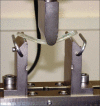Effect of comonomer of methacrylic acid on flexural strength and adhesion of Staphylococcus aureus to heat polymerized poly (methyl methacrylate) resin: An in vitro study
- PMID: 28584416
- PMCID: PMC5450892
- DOI: 10.4103/jips.jips_257_16
Effect of comonomer of methacrylic acid on flexural strength and adhesion of Staphylococcus aureus to heat polymerized poly (methyl methacrylate) resin: An in vitro study
Abstract
Aims and objective: The purpose of the present study was to evaluate and compare flexural strength and Staphylococcus aureus adhesion of heat-activated poly (methyl methacrylate [MMA]) resin modified with a comonomer of methacrylic acid (MAA) and MMA monomer.
Materials and methods: Comonomer preparation was done with the addition of varying concentration of MAA (0, 15, 20, and 25 wt %) to the MMA of conventional heat-activated denture base resin to prepare the specimens. Prepared specimens were stored in distilled water at 37°C for 1 day and 1 week before the evaluation of flexural strength and microbial adhesion. Flexural strength was measured using a universal testing machine at a crosshead speed for 2 mm/min (n = 10). Microbial adhesion (colony-forming unit [CFU]) was evaluated against S. aureus using a quadrant streaking method (n = 5). Data were subjected to one-way ANOVA, and the significant differences among the results were subjected to Tukey's HSD test. P < 0.05 was considered statistically significant.
Results: Addition of MAA to the MMA monomer was found to significantly reduce the adhesion of S. aureus for all the groups. Reduction of CFU of S. aureus was found be more significant for Group 3 as compared to control, both at 1-day (P < 0.001) and 1-week (P < 0.002) storage in distilled water. However, no statistically significant changes in the flexural strength were observed with the addition of MAA at 1-day (P = 0.52) and 1-week (P = 0.88) time interval.
Conclusion: Addition of MAA to conventional denture base resin reduced the microbial adhesion without significantly affecting the flexural strength.
Keywords: Flexural strength; Staphylococcus aureus; heat polymerized acrylic resin; methacrylic acid; microbial adhesion.
Conflict of interest statement
There are no conflicts of interest.
Figures








Similar articles
-
Monomer Modifications of Denture Base Acrylic Resin: A Systematic Review and Meta-analysis.J Pharm Bioallied Sci. 2019 May;11(Suppl 2):S112-S125. doi: 10.4103/JPBS.JPBS_34_19. J Pharm Bioallied Sci. 2019. PMID: 31198322 Free PMC article. Review.
-
A comparative evaluation of flexural strength of commercially available acrylic and modified polymethylmethacrylate: an in vitro study.J Contemp Dent Pract. 2013 Jan 1;14(1):80-3. doi: 10.5005/jp-journals-10024-1275. J Contemp Dent Pract. 2013. PMID: 23579899
-
Effect of repair resin type and surface treatment on the repair strength of heat-polymerized denture base resin.J Prosthet Dent. 2014 Jan;111(1):71-8. doi: 10.1016/j.prosdent.2013.09.007. Epub 2013 Oct 22. J Prosthet Dent. 2014. PMID: 24161257
-
Effect of aluminum oxide addition on the flexural strength and thermal diffusivity of heat-polymerized acrylic resin.J Prosthodont. 2008 Aug;17(6):439-44. doi: 10.1111/j.1532-849X.2008.00318.x. Epub 2008 May 9. J Prosthodont. 2008. PMID: 18482365
-
Comparative Study to Assess the Effectiveness of Various Disinfecta- nts on two Microorganisms and the effect of same on Flexural Strength of Acrylic Denture Base Resin - An In Vitro Study.J Int Oral Health. 2013 Jun;5(3):55-62. Epub 2013 Jun 23. J Int Oral Health. 2013. PMID: 24155603 Free PMC article.
Cited by
-
Properties of Experimental Dental Composites Containing Antibacterial Silver-Releasing Filler.Materials (Basel). 2018 Jun 18;11(6):1031. doi: 10.3390/ma11061031. Materials (Basel). 2018. PMID: 29912158 Free PMC article.
-
Effect of Silver-Emitting Filler on Antimicrobial and Mechanical Properties of Soft Denture Lining Material.Materials (Basel). 2018 Feb 22;11(2):318. doi: 10.3390/ma11020318. Materials (Basel). 2018. PMID: 29470441 Free PMC article.
-
Monomer Modifications of Denture Base Acrylic Resin: A Systematic Review and Meta-analysis.J Pharm Bioallied Sci. 2019 May;11(Suppl 2):S112-S125. doi: 10.4103/JPBS.JPBS_34_19. J Pharm Bioallied Sci. 2019. PMID: 31198322 Free PMC article. Review.
-
Stress Relaxation Behavior of Poly(Methyl Methacrylate)/Graphene Composites: Ultraviolet Irradiation.Polymers (Basel). 2022 Oct 6;14(19):4192. doi: 10.3390/polym14194192. Polymers (Basel). 2022. PMID: 36236140 Free PMC article.
-
Effect of zirconia nanoparticles in heat-cured acrylic resins on bacterial adhesion in vegan beverages.Appl Microbiol Biotechnol. 2025 Mar 25;109(1):76. doi: 10.1007/s00253-025-13457-7. Appl Microbiol Biotechnol. 2025. PMID: 40131518 Free PMC article.
References
-
- Park SE, Periathamby AR, Loza JC. Effect of surface-charged poly (methyl methacrylate) on the adhesion of Candida albicans. J Prosthodont. 2003;12:249–54. - PubMed
-
- Samaranayake LP, McCourtie J, MacFarlane TW. Factors affecting the in-vitro adherence of Candida albicans to acrylic surfaces. Arch Oral Biol. 1980;25:611–5. - PubMed
-
- Segal E, Lehrman O, Dayan D. Adherence in vitro of various Candida species to acrylic surfaces. Oral Surg Oral Med Oral Pathol. 1988;66:670–3. - PubMed
-
- Cannon RD, Chaffin WL. Oral colonization by Candida albicans. Crit Rev Oral Biol Med. 1999;10:359–83. - PubMed
LinkOut - more resources
Full Text Sources
Other Literature Sources
